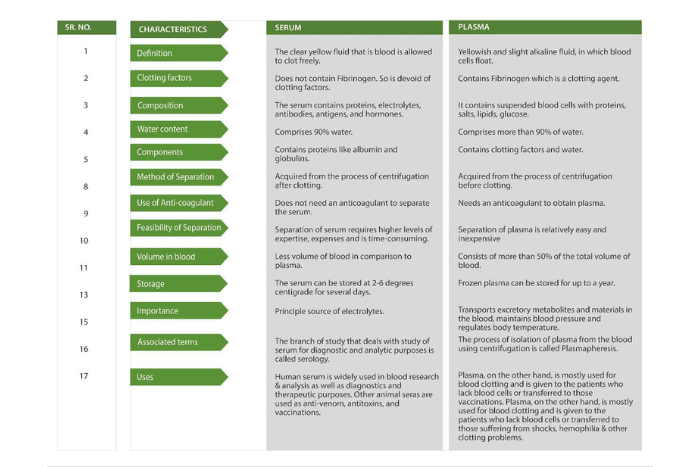Serum or Plasma: What are their uses, and which is better for research purposes?
Blood and serum are two of the most essential components of blood. While both comprise the liquid elements of the connective tissue that is blood, they differ in many ways and have various applications in medical research.
We know that blood extraction and collection is a common routine, one which enables us to:
- understand and determine the general health of an individual
- track and monitor diseases,
- measure the effects of therapeutic treatments or interventions and
- gauge the impact of lifestyle and nutrition.
Plasma and serum, which represent what remains after the blood cells are removed, are the most often collected samples from blood. Blood plasma and serum abound in a wide range of indicators that can offer crucial diagnostic information and insight on systemic health.
Helvetica Health Care (HHC), a renowned supplier of high-quality blood plasma and serum samples gives you an insight on the differences between plasma and serum, their importance and their uses in medical research to assist you in the right selection of samples to produce accurate and reliable results.
What is blood plasma?
Plasma comprises the liquid portion of blood that contains fibrinogen, a blood clotting agent. The extraction of both blood plasma and serum is done using a centrifuge. Plasma is the part that is obtained before the blood coagulates. In other words, when an anticoagulant is added to prevent clotting, plasma is the liquid component that remains.
Plasma consists of more than 50% of the total volume of blood. The role of blood plasma is essential to the human body because it minimises excessive blood loss during injury and comprises almost 90% water. Some of the substances transported by blood plasma are proteins that carry critical nutrients such as salts, glucose and lipids to the different parts of the body. Furthermore, plasma regulates the body temperature and controls blood pressure.
Plasma donations play a crucial role in treating patients who have lost a lot of blood, and in turn, plasma, either during a medical procedure or a severe accident. Given the important functions of blood plasma, a significant loss can seriously impact someone’s health.
What is serum?
Serum is the liquid portion that remains when blood is allowed to clot freely. The blood contains more serum than plasma. In comparison to plasma, serum is widely used in blood research & analysis and diagnostics.
Below we list the main differences between serum and plasma, which will help you understand them better.
What are the uses of blood plasma and serum in medical research?
Both serum and plasma are used extensively in medical research and for diagnostic purposes for testing biomarkers indicative of certain serious health conditions.
The use of serum and plasma samples for research is particularly alluring, given their minimal invasiveness and the abundance of biological data that may be discovered in both healthy and illness states. Biomarkers produced from serum and plasma samples are being studied and used in more clinical applications. These developments can help us better understand and treat various illnesses.
Which is better for research?
The selection between these two essential blood components depends on the requirements of the research assay or specific application performed and the technology used across various scientific domains.
Serum may be preferable since blood has a higher concentration of it than plasma and because it doesn’t require additional substances like Ethylenediaminetetraacetic acid (EDTA) to prevent blood samples from clotting. Furthermore, serum has higher sensitivity than plasma which enables the detection of more biomarkers when studying various phenotype groups and their sub-groups.
On the other hand, plasma samples are more efficient and precise in determining metabolite outcomes with improved consistency between samples. Typically, the use of plasma is highly favoured in proteomic methods. In clinical use, plasma is frequently used for blood transfusion because it contains anticoagulants that stop clot formation. People with chronic illnesses like haemophilia, autoimmune diseases, and liver disease may benefit from the therapeutic use of plasma.
Both plasma and serum contain antibodies frequently utilised for developing immunities against infectious diseases such as the recent Covid-19 virus, Ebola and anthrax. Equally, numerous monoclonal antibodies have been isolated and identified from serum or plasma for various therapeutic purposes involving the treatment of inflammatory disorders like lupus and rheumatoid arthritis.
In recent years, based on the findings from early-phase clinical trials, plasma collected from young donors also demonstrates symptoms of clinical benefits in individuals with early-stage Alzheimer’s disease.
By this token, plasma and serum have a fundamental role in medical research and diagnostics, which extends to the development of therapeutic treatments to combat a range of health concerns, from metabolism to cancer.
Usually, experts recommend using plasma and serum samples to understand how each behaves to the application, whether in the running of an assay, performing a diagnostic test or contributing a cell culture. You may receive false results when only one sample has been used.
Sample discrepancies in serum and plasma collection are another problem that lab specialists are often confronted with because they lead to inconsistent outcomes. Approximating the quality of the plasma or serum sample in some applications using certain markers is possible.
HHC specialises in supplying a range of clinical/biological samples with needed characterisation, special material including POSITIVE HUMAN BLOOD, PLASMA and SERUM, animal material and BIOPSY SAMPLES.
Thanks to our wide network, we can source material in more than 50 countries worldwide and provide access to a network of clinical laboratories, transfusion centres, reference centres and pathology laboratories. We can also offer a prospective sample collection based on the required parameter and specifications.
We also have access to large volumes of high-grade Human Serum, pooled or individual, and negative plasma in EDTA or Citrate.
ZEPTOGEL and SCRUBBED NYLON FIBERS are used to separate and isolate human lymphocytes from whole blood samples. Lymphocytes prepared by these methods are viable cell suspensions for tissue culture and enzymatic, biochemical and immunologic studies employing small volumes of blood.
Please read some of our previous articles to learn more about blood plasma and serum. To learn more about our products, please visit our website: https://www.h-h-c.com

